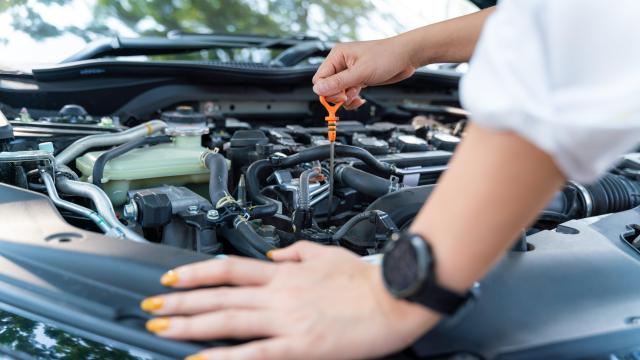Freak accidents may be out of your control, but the vast majority of “stranded on the side of the highway with no cell service” scenarios can be prevented with a simple, thorough home inspection. Here’s what to look for before hitting the road.
Check belts and hoses for damage
A serious belt or hose malfunction will stop your car dead in its tracks, and neither part is easy to replace. If you’re planning a long trip and it’s been a while since your car had a proper tune-up, checking its belts and hoses for signs of damage is a must.
Different engines use different types and numbers of belts and hoses; it’s important to know what your car has under the hood and how to properly check it out. Looking up inspection tutorials for your car’s make and model on YouTube is definitely a good idea here — you don’t want to miss anything, and a video is easier to follow than your owner’s manual. Checking belts for signs of damage and wear is pretty simple. Here’s what to look for:
- Shiny spots: Worn-out belts can get dangerously slick in spots, causing them to slip out of position. (This type of wear is also called “glazing.”)
- Cracks or fraying: This one’s pretty self-explanatory, but a belt that’s cracked or frayed is a lot closer to snapping than one with no structural damage.
- Loss of tension: Wear and tear can cause belts to stretch out, reducing their tension and making it more likely that they’ll slip.
If your belts pass all three spot checks, you’re good to go; if not, get your car to the shop and have them replaced.
Hoses break down in many of the same ways, but the signs of damage are slightly different. Grab a flashlight and look for these indicators:
- Cracks and bulges: A cracked or bulging hose is more likely to leak. Look carefully for cracks and nicks, especially around the bends; bulges may only be visible when the engine is hot, so use extra caution.
- Glassy or scuffed spots: Heat damage can partially melt hoses, causing them to look shiny and glassy when they harden. Abrasive damage (rubbing) can leave visible scuff marks behind.
- Soft spots: While the engine is cool, squeeze hoses near the clamps and feel for soft or mushy spots. This is a sign of electrochemical degradation (ECD), which breaks down hoses from the inside out.
Check your car tires
The second most important part to check is your tires. Make sure they’re inflated to the correct pressure (which you can find in your owner’s manual or with a quick Google search) and that they have plenty of tread left. The quarter test makes it easy to gauge how worn down the tread is, and whether you need to replace your tires.
Inspect your brake pads
You may not be able (or willing) to replace worn-out brake pads on your own, but you can check to see if they need replacing. Most cars’ brake pads are visible through the holes in the hubcap, so you don’t even need to remove the wheel to see what’s going on. Grab a flashlight, get down to brake pad-level, and see how thick (or thin) the pads are. Generally speaking, if they’re less than 1/4 inch thick, you need new pads — and if they’re wearing unevenly, there’s a good chance your alignment is out of whack.
Check your fluids and top them off
Depending on your transmission situation, your car needs either five or six main types of fluids to run smoothly:
- Engine oil
- Brake fluid
- Transmission fluid (if you drive an automatic)
- Coolant/antifreeze
- Power steering fluid
- Windshield wiper fluid
Knowing how to check your car’s fluids is super important and, thankfully, pretty simple. The first and most important step is to make sure your engine is completely cool before you touch anything; a hot engine pressurizes certain fluids, and you don’t want a face full of hot ethylene glycol. Each fluid’s reservoir should have an easily accessible cap under the hood, along with visible fill lines (or, for oil, a dipstick) to help you see if it needs a refill. Find each cap, pop it open, take a look, and add more fluid if needed.
This is one of those maintenance tasks you should be doing regularly. Checking fluid levels is quick, simple, and it can help you catch leaks early: If you’re constantly low on a certain type, you probably have a leak somewhere and it’s a good idea to take it to a mechanic.
Check your headlights (and wipers, while you’re at it)
Finally, before loading up the car and heading out, make sure that your headlights and windshield wipers are in good shape. There’s nothing worse than realising your car’s visibility aids are busted in the middle of a surprise rainstorm, blizzard, or fog event. (Honestly, if you’ve had your blades for more than a year, just go ahead and change them — it’s cheap, easy, and will make the drive so much better.)
For bonus preparedness points, pick up replacement bulbs and blades and keep them in the car. They don’t take up much room, and you never know you’ll need them. Even if your headlights need an actual mechanic to replace them — which is often the case with newer cars — having the part on hand means you won’t have to wait for an order to come in.

Leave a Reply
You must be logged in to post a comment.